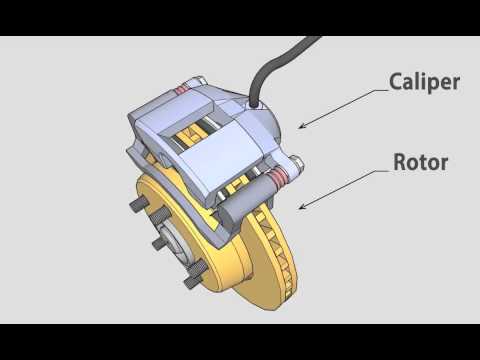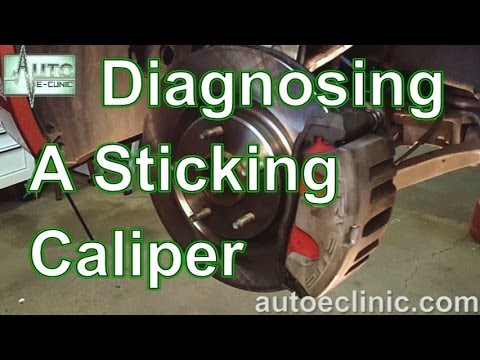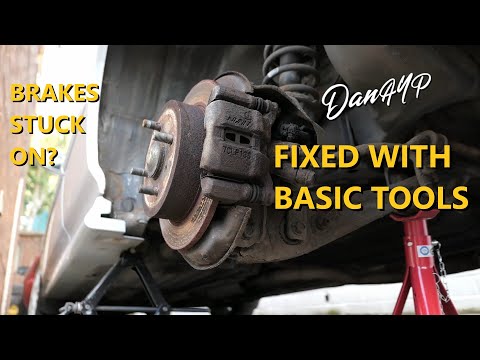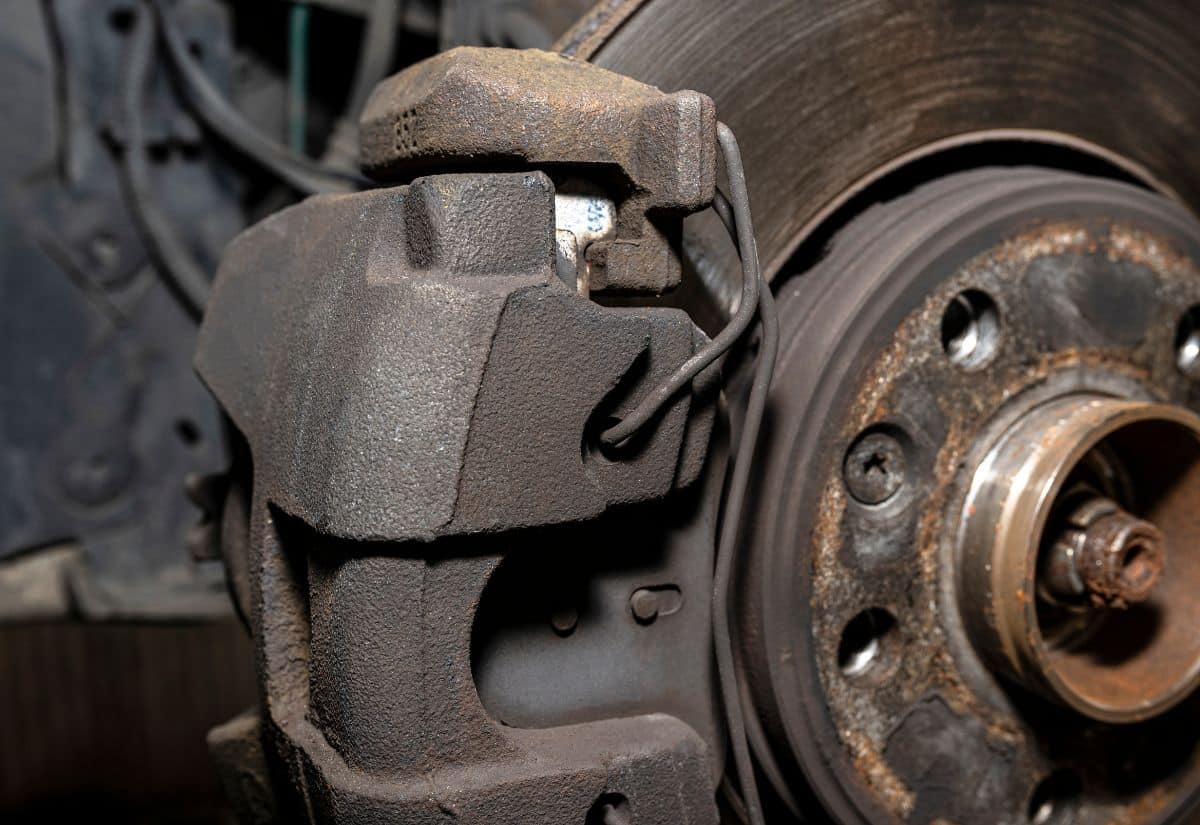
When you have a “brake caliper sticking,” it signifies a serious problem in your vehicle’s braking system. Brake calipers play a pivotal role in your ability to stop the car as they apply pressure to the brake pads. These brake pads, in turn, press against the brake rotors to slow down or stop your vehicle’s forward momentum.
When the caliper sticks or seizes, it fails to retract fully after the braking pressure is released. Consequently, the brake pads continue to apply partial pressure on the rotors, causing resistance even when you’re not applying the brakes.
This continuous friction not only affects your vehicle’s performance and efficiency but it can also lead to serious damage over time.
The symptoms of a sticking brake caliper can vary but usually include the car pulling to one side, a strong burning smell, decreased braking power, and uneven brake or tire wear.
When your brake caliper sticks, it can produce an excessive amount of heat within a short span, thereby charring your brake components and causing damage to your hubs and sensors. Yet, the aftermath doesn’t end there. This rogue caliper also causes uneven tire wear and increased fuel consumption.
It’s a serious safety concern, and the longer you put it off, the more expensive the problem will get.
You can prevent further damage by understanding the reasons behind a sticking caliper and taking appropriate steps to fix it. By tackling the issue head-on, you can get your brake caliper unstuck and be confident in your vehicle’s braking capability.
So, it’s high time we dive deeper into the mechanics of brake calipers and take control of the situation!
How Do Brake Calipers Work?
Brake calipers are the component that pushes the brake pads onto the rotors to slow down a vehicle. Caliper parts include:
When you push down on the brake pedal, a hydraulic system sends pressurized fluid to the calipers. That force pushes out the pistons. As they extend, they push on the back of the brake pads to squeeze down on the brake rotor.
This action creates friction between the pads and rotors, slowing the vehicle.
The pistons slide along inner seals, which are protected from the elements by a flexible rubber boot. Floating calipers move along slider pins as the pistons extend on one side, while fixed calipers have pistons on both sides.
As you release the brake pedal, the hydraulic pressure drops and the caliper pistons retreat into the caliper body. When everything functions properly, this allows the wheels to spin freely again.
The pistons or floating calipers might not move as needed if you have sticking calipers. The brakes can continue putting force between the pads and rotors, quickly wearing through the parts and causing many other problems.
What Really Causes a Brake Caliper to Stick?
There are a variety of reasons that can cause your calipers and brakes to be stuck. Let’s go through some of the most common problems in detail so you can understand the reason behind the sticking caliper.
1. Problematic Boot or Seal
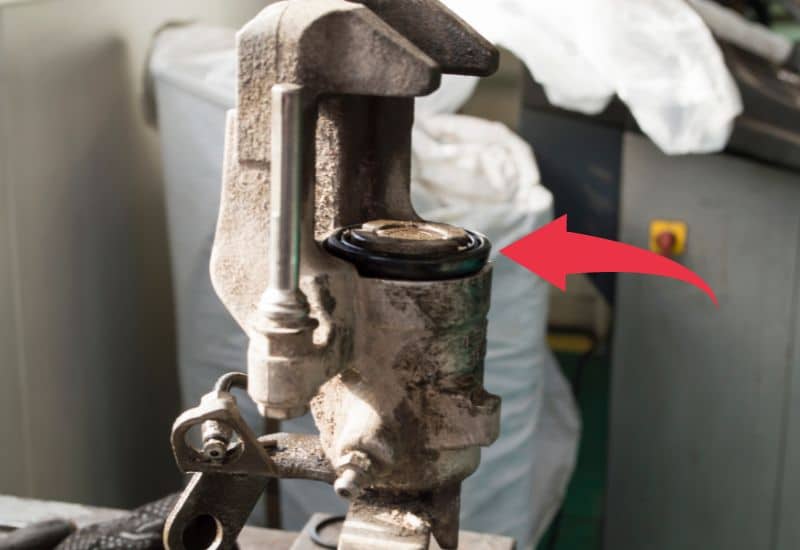
If the protective layer around the calipers is damaged, it allows water, grime, and other debris where they shouldn’t be. The boot’s primary function is to keep these elements outside the caliper piston and seal. When the boot tears, it fails to do its job, and the caliper can stick.
Boots are delicate and can tear without cause or from being handled without care. This is a good reason to use caution when cleaning your brakes during routine maintenance. Hitting the durable metal parts with a wire brush can be a great idea, but that can quickly tear the rubber boot.
If you go a layer beyond the boot, you’ll find the seal that allows the pistons to slide in and out. Under normal function, these seals let the pistons flow back and forth without an issue.
But when the seals get worn, damaged, or have corrosive build-up because of a torn boot, they fail, and the pistons can’t move as they should. The result is a sticking caliper that can burn through your brake pads or not allow the pads to push against the rotor.
2. Faulty Slider Pins or Pistons
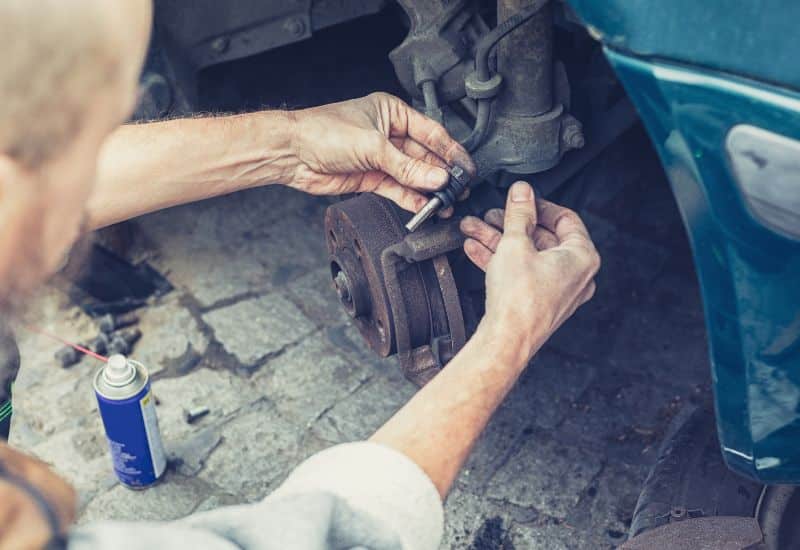
On floating calipers, half of the caliper body needs to move along the slider pins to squeeze on the rotor. If the slider pins are caked with rust, don’t have enough lubrication, or have any other problem that prevents the problem from sliding, it can cause the calipers to seize up.
Slider pins are directly exposed to the elements and can be a recurring issue, especially without proper lubrication during routine maintenance or if left to corrode without cleaning or attention. Some people who drive in challenging conditions will lubricate the slider pins annually to prevent problems. While they might seem insignificant to the untrained eye, they’re vital parts of a functioning floating caliper.
If pistons get damaged, have cracks, or show any flaws, it can result in stuck calipers. The pistons are the central component of the brake caliper as they push against the brake pads. They’re also built with fairly tight tolerances, so the seal wraps tightly around them.
When the pistons can’t move like they should because of flaws in the metal piston, such as deep pitting caused by debris allowed in by a torn boot, it can cause a caliper to stick. It might get stuck fully extended and have the brake engaged fully, or it could get blocked from pushing out and not allow that caliper to provide braking power.
3. Bad Brake Fluid, Line, or Booster
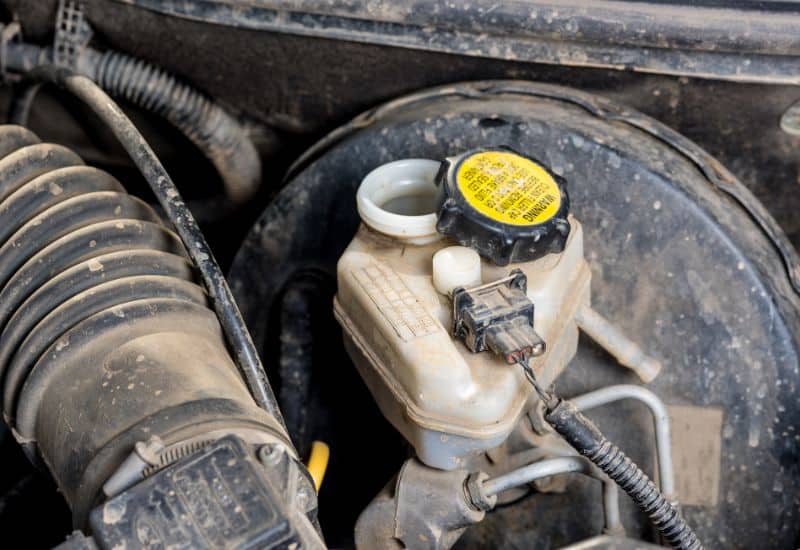
If any part of the hydraulic system that provides braking force has issues, your brake calipers can stick. Many times, debris inside the brake line prevents the flow of fluid. Water can seep into the lines and freeze, or even dirt can sneak in and build up over time and block the line.
The brake lines are carefully designed to ensure the fluid moves as it should. The inside is much more fragile than they appear since most of them are braided. If anyone fails to handle the brake lines during maintenance carefully, it can cause internal damage that might not be obvious.
If the lines are bent, broken, or blocked, your brake calipers won’t be able to function like they need to. You’ll push on the pedal, and the force won’t get sent to the calipers, making it seem like your calipers are stuck.
Another part that can cause a sticking caliper is a faulty brake booster. This problem usually appears as an issue with all the brake lines, but sometimes, it can only present itself in one caliper and make it seem like a stuck caliper. Sometimes, the booster will send just enough pressure to one caliper so it sticks and stays constantly engaged.
4. Failure of Other Brake Parts

Other brake parts can also be the culprit behind a sticking brake caliper. If the pads are in poor condition, like when they’re overly worn, they can get lodged in the caliper or rotor in an odd position and prevent the caliper from releasing pressure.
Worn rotors can cause a similar problem. Even brakes that have been overheated can melt together and cause sticking calipers or other problems with identical symptoms.
They could get stuck in the engaged position if the emergency or parking brake fails. Some vehicles use the calipers as part of the parking brake system instead of a drum-brake system inside of the rotor. So even if you try to disengage it by releasing the parking brake from the cabin, the part remains stuck, and your brake calipers might stay engaged.
Finally, the anti-lock brake system and its sensors can also cause sticking brake calipers. When sensors are faulty, they can erroneously override your input and apply the brakes. This will seem like the caliper is stuck when it’s the ABS overriding and engaging the brakes in an attempt to protect your safety.
Clear Symptoms of a Sticking Brake Caliper You Shouldn’t Ignore
You can watch out for some easy-to-identify signs if you think your brake calipers are sticking. One of the most obvious and dangerous signs happens when the brakes overheat. You’ll likely smell something burning or see smoke.
Another major symptom of a sticking brake caliper is when the car pulls to one side. It might feel like one wheel is constantly dragging with the brake applied. Or it could happen when you push the brakes, and it seems like one side doesn’t engage.
A lack of braking power, a spongy brake pedal feel, or vibrations upon pressing the brakes are other common symptoms of a sticking brake caliper.
The results may include increased fuel consumption or slower acceleration as if your brakes are always applied. Your brakes might make noise since the pads will wear down quickly or unevenly.
Why Ignoring a Sticking Brake Caliper Can Lead to Costly Consequences
Whenever you notice problems with your brakes, especially something as serious as a sticking caliper, you should immediately take care of it.
If you drive with a sticking brake caliper, it can burn through pads and rotors and generate heat that far exceeds safe levels. This heat can damage or destroy other expensive parts, such as the hub bearing, the anti-lock brake or speed sensors, tire damage, excessive wear, and increased fuel costs.
Worst of all, failing to repair sticking calipers can result in brake failure, making it so you are riding on a giant metal brick with no way to slow down.
A sticking caliper might not be a big deal at first. If you take care of it quickly, you might have an extremely low-cost repair, such as a good cleaning and lubrication. You can also rebuild calipers or replace slider pins for less than $20.
But if you let the damage continue for too long, these affordable repair options go out the window along with your safety. The damage spreads and becomes a more severe issue requiring replacement parts.
A Step-by-Step Guide to Diagnosing a Sticky Brake Caliper
Identifying problems with a sticky brake caliper is something most people can do. Here is a step-by-step guide to help you diagnose a sticky caliper:
If you follow these steps, you should be able to find any sticky calipers.
Step-by-Step Guide to Fixing Brake Calipers Like a Pro
If you have some mechanical ability, there are low-cost options to try before spending money on replacement parts or taking it to a mechanic.
But if you aren’t comfortable working on your vehicle, you probably don’t want to start with a brake system problem. It’s one thing to drive a short distance to a shop with a sticking caliper, but messing up a brake repair is another level of disaster.
Here is how to fix a sticking brake caliper:
How do you prevent the brake caliper from sticking in the future?
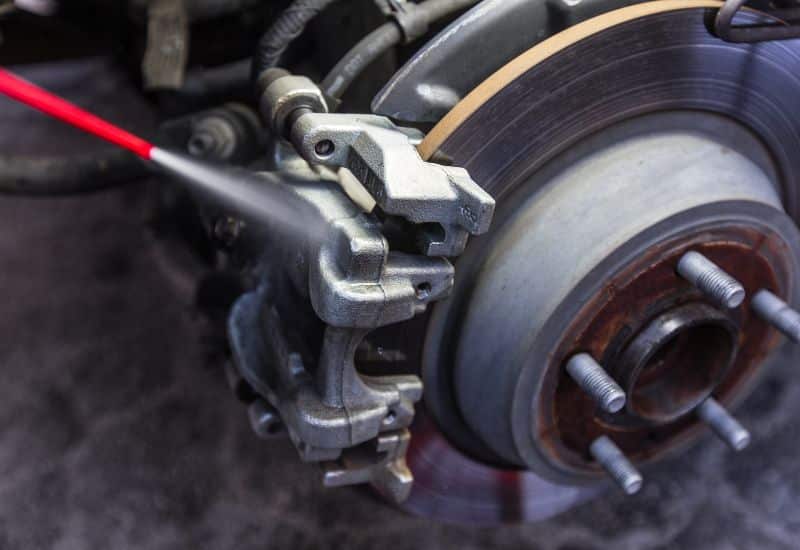
Brake calipers typically last a long time if properly cared for. To prevent the brake caliper from sticking in the future, stay on top of regular brake maintenance, such as replacing pads and rotors and bleeding the brakes.
Keeping the brakes and wheels clean is another way to ensure the longevity of your brake calipers. This is especially important if you drive on dirt or dusty roads, in areas with corrosive snowmelt chemicals, or near salt water.
Don’t allow your brakes to overheat. Rather than riding your brakes down steep descents, apply pressure to slow the vehicle in short bursts, then release to allow them to cool. If you ever smell your brakes burning or see smoke, stop as soon as it’s safe, let them cool, and inspect for damage. Burning brakes is not normal, cause for concern, and is a reason to adjust driving behavior or inspect your brakes.
If you feel any problems with your brakes, such as vibrations, decreased stopping power, pulling to one side, spongy brake pedal, or any other changes in braking power, take care of the problem by getting it diagnosed and repaired.
Is it OK to drive with a sticking caliper?
It is not recommended to drive with a sticking caliper. It can generate a lot of heat in a very short distance, which can burn through brake parts and decrease your stopping power. Driving with sticking calipers will also cause the damage to spread and can turn an inexpensive repair into a costly replacement service needing new parts.
Can you lubricate a brake caliper piston? If yes, with what?
Yes, you can lubricate a brake caliper piston, the slider pins, and other moving brake parts. Do not grease the surface of the brake pads or rotors. Use a brake-specific lubricant, typically waterproof silicone grease that can handle the high heat and challenging environments.
Sticky Caliper No More
Brake calipers are essential to slowing down your car. As you press on the brake pedal, hydraulic fluid goes through your brake lines and pushes the caliper’s pistons onto the back of the brake pads, squeezing the rotor and stopping your car.
When problems creep up due to rust, a torn boot, faulty inner seal, seized pistons, bad slider pins, contaminated brake fluid, bent brake lines, faulty brake booster, worn pads or rotors, overheated brakes, or issues with the emergency brake or anti-lock system, your calipers can stick.
Keep an eye out for pulling to one side, burning brakes, increased fuel consumption, uneven brakes, or tire wear as these can all be symptoms of sticking brake calipers. Ignoring these issues can generate heat, damage other components, and be a serious safety issue that makes it so you can’t stop your car.
Figure out which caliper is sticking by jacking it up, spinning the wheels, and inspecting the caliper. Then, repair the problem by lubricating, rebuilding, or replacing the caliper and taking care of any other brake needs. This will get you back on the road safely and could only require a tube of grease and some time.

Written By
Jason Farrell
Jason Farrell is a certified master technician, the editor of Mechanic’s Diary in Pittsburgh, Pennsylvania. He is ASE (Automotive Service Excellence) certified and earned a Bachelor’s Degree in Automotive Technology from Pittsburg State University. With nearly 18 prior years of experience in the automotive field, he has extensive knowledge about Domestic, European, and other foreign makes and models of cars and light trucks. Jason’s experience working as a technician and service manager at dealerships, gave him the experience and know-how of most aspects of inspection, diagnosis, and repair from engine and drivability to electrical, HVAC, brakes, steering and suspension and everything in between.

